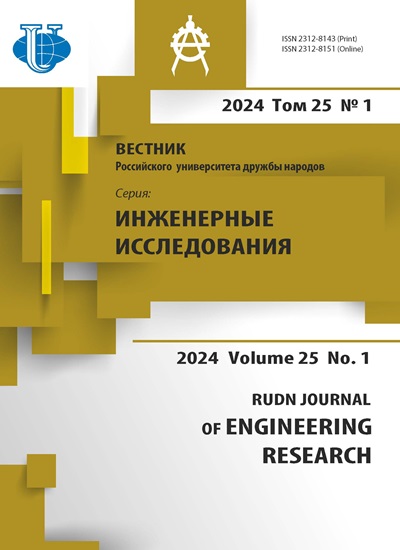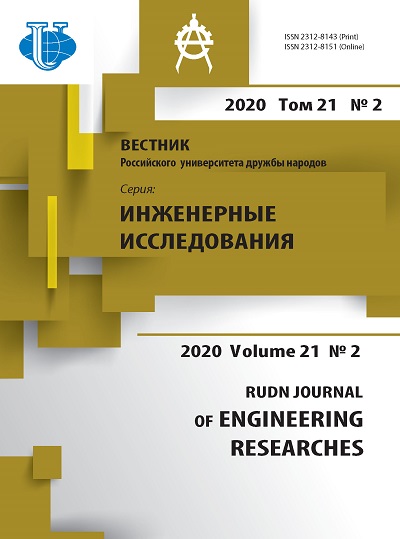Some peculiarities of the polarization structure of the electromagnetic field at high frequencies in geological sections: mathematical solutions and experiments
- Authors: Abramov V.Y.1
-
Affiliations:
- Peoples’ Friendship University of Russia (RUDN University)
- Issue: Vol 21, No 2 (2020)
- Pages: 123-130
- Section: Earth science
- URL: https://journals.rudn.ru/engineering-researches/article/view/25550
- DOI: https://doi.org/10.22363/2312-8143-2020-21-2-123-130
Cite item
Full Text
Abstract
The effects of induced polarization (IP) in the ore bodies and host rocks in the frequencies above 1 000 000 Hz were considered. The phase response of the complex resistivity (CR) system equipment “Geozond” have been explored instrumentally. The reliability of high-frequency IP measurements was confirmed by independent verification by mining activities. The results confirm the presence of IP effects in the ore bodies and host rocks. They suggest the necessity to account for IP effects in the interpretation of electromagnetic data, in particular, in induction logging data. The purpose of mathematical computer modeling in this work was to study the propagation of a high frequency electromagnetic field from a linear current source in a material medium by solving Maxwell's equations using finite-difference approximations (iterations) in the time domain. The measurement results were processed according to a well-known scheme, using the method of iterative selection in automatic mode. This allows to use this method for end-to-end calculation of electromagnetic fields in complex three-dimensional inhomogeneous structures.
About the authors
Vladimir Yu. Abramov
Peoples’ Friendship University of Russia (RUDN University)
Author for correspondence.
Email: geophy-rudn@mail.ru
Associate Professor of Department of Geology, Mining and Oil & Gas Engineering of RUDN University; Candidate of Geological Sciences
6 Miklukho-Maklaya St, Moscow, 117198, Russian FederationReferences
- Dmitriev V, Serebrennikov N. Numerical calculation of the electric field of a point source in a layered medium with axisymmetric inclusion. Proceedings of higher educational establishments. Geology and Exploration. 1987; (2):112–117. (In Russ.)
- Ivanov VT, Krizsky VN. Solution of some problems of electrical exploration by the method of boundary integral equations. Proceedings of higher educational establishments. Geology and Exploration. 1993;(4):112–117. (In Russ.)
- Manaeva EN, Postnikov EB. Electromagnetic processes near the front of a step pulse in the case of electromagnetic sounding of the Earth in the case of a weakly homogeneous conducting medium. Proceedings of higher educational establishments. Geology and Exploration. 2002;(3):104–108. (In Russ.)
- Matematicheskoe modelirovanie elektromagnitnykh polei: materialy mezhdunarodnogo proekta COMMEMI [Mathematical modeling of electromagnetic fields: materials of the international project COMMEMI]. Moscow: Nauka Publ.; 1992. (In Russ.)
- Pashkova TI, Postnikov EB, Sobolev SV. On the interaction of electromagnetic pulses of stepped and rectangular forms with the Earth's surface. Proceedings of higher educational establishments. Geology and Exploration. 1999;(5):115–119. (In Russ.)
- Redozubov AA. On the orientation of polar diagrams NK and PK in an anisotropic medium. Proceedings of higher educational establishments. Geology and Exploration. 1994;(2):119–122. (In Russ.)
- Talalov AD. Model of electrical properties of water-saturated rocks for the frequency range of 103–109 Hz. Proceedings of higher educational establishments. Geology and Exploration. 2003;(1):75–80. (In Russ.)
- Talalov AD, Dayev DS. Laboratory studies of the frequency dependence of the electrical properties of clay rocks in the range of 20–109 Hz. Proceedings of higher educational establishments. Geology and Exploration. 1997;(6):123–129. (In Russ.)
- Burtman V, Endo M, Zhdanov MS, Ingeman‐Nielsen T. High‐frequency induced polarization measurements of hydrocarbon‐bearing rocks. SEG Technical Program Expanded Abstracts. 2011:677–681. https://doi.org/ 10.1190/1.3628168
- Zhdanov MS, Spichak VV. Matematicheskoe modelirovanie elektromagnitnykh polei v trekhmerno-neodnorodnykh sredakh [Mathematical modeling of electromagnetic fields in three-dimensional inhomogeneous media]. Moscow: Nauka Publ.; 1992. (In Russ.)
- Taflav A, Umashankar KR. Numerical simulation of electromagnetic wave scattering calculation of the effective area of reflection of targets by the finite-difference method in the time domain. TIIER. 1989;77(5):57–76. (In Russ.)
- Zhou Pei-bai. Numerical analysis of electromagnetic fields. Berlin: Springer; 1993.
- Binns KJ, Lawrenson PJ, Trowbridge CW. The analytical and numerical solution of electric and magnetic fields. John Wiley & Sons; 1992.
- Booton RC. Computation methods for electromagnetic and microwaves. John Wiley & Sons; 1992.
- Paul CR. Introduction to electromagnetic compatibility. John Wiley & Sons; 1992.
- Sylvester P, Ferrari R. Metod konechnykh elementov dlya radioinzhenerov i inzhenerov-elektrikov [Finite element method for radio engineers and electrical engineers]. Moscow: Mir Publ.; 1986. (In Russ.)
- Yee KS. Numerical solution of initial boundary value problems involving Maxwell’s equations in isotopic media. IEEE Trans. and Antennas and Prop. 1966; AP–14(3):302–307.
- Crawford F. Volny [Waves]. 3rd ed. Moscow: Nauka Publ.; 1984.
- Selunsky AB, Kuzmin AV, Komarova NYu. Teplovoe pogloshchenie ploskoi elektromagnitnoi volny proizvol'noi polyarizatsii na sinusoidal'noi granitse vodnoi poverkhnosti [Thermal absorption of a plane electromagnetic wave of arbitrary polarization at the sinusoidal boundary of the water surface]. Moscow: IKI RAS Publ.; 2013. (In Russ.)
















